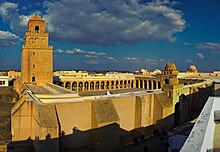
Back جامع عقبة بن نافع Arabic جامع عقبه بن نافع ARZ Ғүҡбә мәсете Bashkir Мячэць Укба Byelorussian কাইরুয়ান জামে মসজিদ Bengali/Bangla Moskeenn veur Kairouan Breton Ukbetova džamija BS Gran Mesquita de Kairuan Catalan Velká kajruvánská mešita Czech Mosg Mawr Kairouan Welsh
| Great Mosque of Kairouan | |
|---|---|
 | |
| Religion | |
| Affiliation | Islam |
| Status | Active |
| Location | |
| Location | Kairouan, Tunisia |
| Architecture | |
| Style | Aghlabid, Islamic |
| Groundbreaking | 670 |
| Minaret(s) | 1 |

The Great Mosque of Kairouan (Arabic: جامع القيروان الأكبر), also known as the Mosque of Uqba (جامع عقبة بن نافع), is a mosque situated in the UNESCO World Heritage town of Kairouan, Tunisia and is one of the largest Islamic monuments in North Africa.[1]
Established by the Arab general Uqba ibn Nafi in the year 50 AH (670AD/CE) at the founding of the city of Kairouan, the mosque occupies an area of over 9,000 square metres (97,000 sq ft). It is one of the oldest places of worship in the Islamic world, and is a model for all later mosques in the Maghreb.[2] Its perimeter, of about 405 metres (1,329 ft), contains a hypostyle prayer hall, a marble-paved courtyard and a square minaret. In addition to its spiritual prestige,[3] the Mosque of Uqba is one of the masterpieces of Islamic architecture,[4][5][6] notable among other things for the first Islamic use of the horseshoe arch.
Extensive works under the Aghlabids two centuries later (9th Cent.AD/CE) gave the mosque its present aspect.[7] The fame of the Mosque of Uqba and of the other holy sites at Kairouan helped the city to develop and expand. The university, consisting of scholars who taught in the mosque, was a centre of education both in Islamic thought and in the secular sciences.[8] Its role at the time can be compared to that of the University of Paris in the Middle Ages.[9] With the decline of the city from the mid-11th century, the centre of intellectual thought moved to the University of Ez-Zitouna in Tunis.[10]
- ^ || Géotunis 2009 :: Kairouan ||
- ^ Great Mosque of Kairouan (discoverislamicart.org) Archived 2013-04-07 at the Wayback Machine
- ^ "Great Mosque of Kairouan – Kairouan, Tunisia". Archived from the original on 2019-08-15. Retrieved 2009-08-24.
- ^ "Kairouan – UNESCO World Heritage Centre". Archived from the original on 2022-08-23. Retrieved 2019-12-26.
- ^ "Kairouan 499" (PDF). Archived (PDF) from the original on 2012-10-26. Retrieved 2019-12-26.
- ^ The Great Mosque (kairouan-cci2009.nat.tn)[dead link][permanent dead link]
- ^ (in French) M’hamed Hassine Fantar, De Carthage à Kairouan: 2000 ans d’art et d’histoire en Tunisie, éd. Agence française d’action artistique, Paris, 1982, p. 23
- ^ Wilfrid Knapp and Nevill Barbour, North West Africa : a political and economic survey, Editions Oxford University Press, Oxford, 1977, page 404
- ^ Henri Saladin, Tunis et Kairouan, Editions Henri Laurens, Paris, 1908, page 118
- ^ Mahmud Abd al-Mawla, L’université zaytounienne et la société tunisienne, éditions Maison Tiers-Monde, Tunis, 1984, page 33